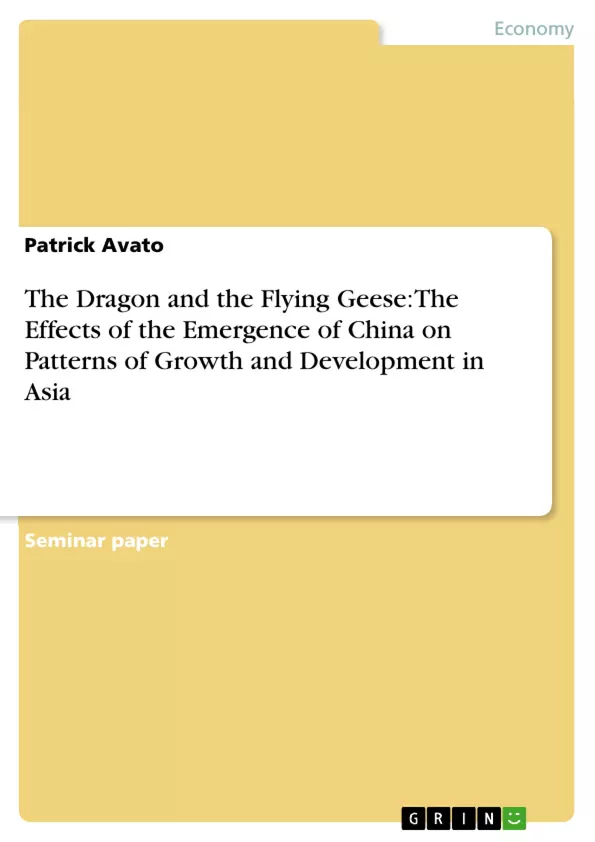For the past 30 years, Asian economies have been the world’s envy as they have surpassed practically every other region in terms exports and economic growth. The remarkable development of various Asian countries has drawn millions of people out of poverty and created some of the wealthiest and most competitive economies in the world. Much of this success has been attributed to a distinctly Asian development model that combines high work ethics with an exceptional emphasis on savings and high rates of investment in both infrastructure and human capital. Moreover, the Asian Miracle was also facilitated by the extraordinary complementarily of resources, stages of development and policies of Asian countries. This complementarily made possible a pattern of development known as the Flying Geese model, in which capital, technologies and know-how trickled down, first from Japan to the Tiger economies (Taiwan, Korea, Singapore and Hong Kong) and then to the Aspirant Tigers of Southeast Asia (Thailand, Malaysia, Indonesia and the Philippines), fostering economic development throughout the region. During the 1990s, however, this picture changed abruptly. First, a real estate and equity bubble developed in Japan, the bursting of which dragged Japan into a decade long economic crisis. Second, China emerged as a major player in the world economy as her strategy of opening up to FDI and redirecting economic activity towards exports began to pay off. In the following paper, I analyze how the spectacular rise of China has affected the patterns of Asian economic dynamics since the early 1990s. In particular, I focus on the question weather the win-win situation of economic complementarily of the past has given way to a zero sum competitive game in which the Asian economies fiercely compete for the same FDI inflows and the same export markets.
Inhaltsverzeichnis (Table of Contents)
- Introduction
- The Complementarities of Asian Economic Dynamics
- The Asian Miracle
- China's Awakening
- The Effect of China on Asian Trade and FDI
- China and the Future of Asian Economic Dynamics
Zielsetzung und Themenschwerpunkte (Objectives and Key Themes)
This paper examines how the emergence of China has impacted patterns of economic growth and development in Asia since the early 1990s. The main goal is to analyze whether the win-win situation of economic complementarity in the past has given way to a zero-sum competitive game, where Asian economies fiercely compete for the same FDI inflows and export markets. The paper explores the evolution of trade and FDI flows in Asia, particularly the effect of rising Chinese exports and FDI inflows on selected Asian economies.
- The role of economic complementarity in Asian economic growth
- The impact of China's emergence on Asian trade and FDI
- The competitive dynamics between China and other Asian economies
- The future of Asian economic dynamics in the context of China's rise
- The evolution of the Flying Geese pattern of development
Zusammenfassung der Kapitel (Chapter Summaries)
- Introduction: This chapter introduces the Asian Miracle and its key drivers, focusing on the complementarity of Asian economies and the Flying Geese model of development. It also highlights the impact of Japan's economic crisis and China's emergence as a major player on Asian economic dynamics.
- The Complementarities of Asian Economic Dynamics: This chapter elaborates on the factors that have contributed to the success of Asian economies, particularly the inclusive domestic policies and institutions that have fostered high investment in infrastructure and human capital. It also examines the complementarity of Asian economies in terms of their endowments with natural resources, human resources, and levels of development.
Schlüsselwörter (Keywords)
Key concepts and terms explored in this paper include Asian economic dynamics, complementarity, Flying Geese model, China's emergence, trade flows, FDI inflows, competitive advantage, and economic development.
- Quote paper
- Patrick Avato (Author), 2006, The Dragon and the Flying Geese: The Effects of the Emergence of China on Patterns of Growth and Development in Asia, Munich, GRIN Verlag, https://www.grin.com/document/58727



